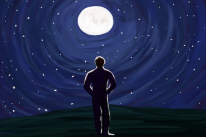
“Compassion is not a relationship between the healer and the wounded. It’s a relationship between equals.” ~Pema Chodron
The technical term is Baader-Meinhof phenomenon. This is when one stumbles upon a new, unfamiliar, or unusual piece of information, and soon encounters that same subject again, within a short time, sometimes repeatedly.
So, for example, you decided to take the plunge for that hipster, purple hair streak that you thought was so punk rock, but now you see it on everyone.
You have recently been car shopping, narrowing it down to a couple of choices, and now Honda Fits are having babies everywhere you look.
Or you just stumbled on the amazing word “phantasmagorical.” See, I passed it along and now I bet you are going to see this word everywhere.
The Baader-Meinhof phenomenon has been showing up for me within the context of healing, helping, and service. They seem to be popping out of the woodwork: people who are searching, no longing, to have their occupation better reflect their desire to help others. And it is a gorgeous, hopeful thing.
Whether it is a natural paradigm swing related to politics, racial injustices, our climate crisis, or just a general craving to hold the warm pulse of our shared humanity, people are wanting to do more. We know the planet does not need more stockbrokers. But we feel an urgent need for more peacemakers, storytellers, teachers, healers, dreamers, activists, and lovers of all kinds.
I have been swimming in this world of service for the last fifteen years, tending to people’s hearts, minds, and bodies through my work as an acupuncturist and herbalist.
I came to this work with a very open heart, deeply wanting to bring a balm of medicine to the suffering of those around me. Even now I can feel the give-the-shirt-off-my-backness that I possessed in the beginning. It was very beautiful, but not very sustainable.
It continues to be a very fulfilling journey, but there are a few things I wish I had known from the beginning. Because only a few short years into my practice, I began to feel the effects of going “all in” without knowing how to hold healthy boundaries for myself and others.
My slow lowering into the fiery pit of burnout began in subtle ways, like taking more naps. Which turned into not being able to make it through a single day without figuring out when I could get horizontal.
I would often spend the weekend afternoons with my friend the couch, not wanting to leave my perch of pillows. A lifelong exerciser, I no longer had the energy for even a stroll with my dogs around the block. And getting in regular snacks and meals became a new part-time job for fear of blood sugar crashes, with shakes and nausea. My physical form was in full revolt, and I was crispy fried exhausted.
I wish I could say that I have only experienced one bout of adrenal fatigue over the last many years, but the truth is, there have been several. And there are a few words of advice that I wished someone had given me a long time ago, that I pass along to you now.
1. Take time every morning to set up your boundaries.
The topic of energy boundaries is vast, but in the simplest of terms, we need to have practices in place so that we don’t absorb the energy, emotions, or vibrations of those around us.
I don’t care if you are a doctor, a firefighter, a teacher, a health coach, a social worker, a massage therapist, or a hospice nurse, when you work with other people, you will sometimes pick up their stuff. We all experience this in our everyday lives.
For example, you are driving home from work, feeling tired but settled, when your best friend calls you. Without warning she launches into her most horrific day, her delayed work project, her demeaning boss and her backstabbing coworkers. At the end of the conversation she apologies for “dumping on you” and hangs up. And how do you feel? Completely slimmed.
Depending on the exact work you do, the intensity level, the number of interpersonal interactions you have daily, and your own health and sensitivity level, you may need more practices than others. But here is a simple one to start off with.
Every morning before you start your day, take ten minutes to set up your “container.” Your container is really a mirror into your attitude toward yourself. You can see it as a bubble, an egg, or the semi-permeable membrane of a cell. It is not an armoring, but a reflection of your own internal fullness. And most importantly you are arranging your container so that it only contains your vibration or higher, that everything else will shed away.
The more time you allow your imagination to create with this, the stronger your container will feel.
2. Take time every evening to clear and let go of anything that is not yours.
Will your container function perfectly all day long? Not usually. It’s natural that when we get tired, overwhelmed, or overworked, your container starts to get some little holes in it. That’s why it’s important to clear all of the energetic debris from your day.
Take ten min before falling asleep to let go of anything you’ve been carrying, or anyone else’s energy that is not yours to hold.
You can do this by welcoming in the elements—letting the water of a shower wash you clean, imagining wind blowing you clear, or seeing your entire old container compost into the earth, like a skin that you are shedding. And then in your mind, make the simple internal request to call your own energy back, any power that you lost over the course of the day while you were in giving mode.
3. Recognize what self-care really is.
Self-care is not some kind of entertainment that allows you to zone out from the challenges of your life. It can’t be bought by shopping therapy. It can’t be applied to the body in the form of more manis and pedis. It is not something that you search for in your external world that you hope will make you feel full and rich inside.
Real self-care is something that fills up your internal well. It’s something that breathes vitality and life force into your container. It adds energy to your system instead of glossing over the surface or giving out more.
Some examples of worthwhile self-care include Qi Gong, Tai Qi, many forms of yoga, chanting, meditation, prayer, and, my favorite of all, being in nature. There is a reason that naturalist, John Muir, so many years ago, figured out that, “into the forest I go to lose my mind and find my soul.”
4. Know that you don’t need to save the world.
Whatever you are doing, it is enough. However small it seems at this time, it’s plenty. When we are really driven by a desire to help others it can often feel like there is always more to do. Or anything we actually do is just a drop in some endless ocean.
Even the word service can be misused and misunderstood. Merriam-Webster defines service as the “occupation of serving,” like you are someone’s servant, or even subservient, which means “below, compliant, obedient.”
Zen Buddhist teacher, Joan Halifax, describes how “it’s sometimes challenging to keep altruism healthy; as we stand at this cliff’s edge, we can be vulnerable to falling into harm.” This is when are we are so excessively focused on helping others that we ignore our own needs. And the truth is that most altruists are really good at giving and really terrible at receiving.
Dr. Barbara Oakley created the term pathological altruism, which she describes as “behavior in which attempts to promote the welfare of another, or others, results instead in harm that an external observer would conclude was reasonably foreseeable.”
This is the teacher that eats a five-minute lunch everyday in order to be ready for her next class and all of her extra responsibilities. This is the nurse that holds her bladder for ten hours, purposely not drinking water, because her rounds are so slammed. This is the activist who “sleeps” on her desk for days and days during a busy voting season.
When the original heart of our giving fades into a kind of exhausted fog, we begin to find our service being dangerously driven by fear, compulsion, and cynicism. When we expect ourselves to save the world, we will inevitably be met with a sense that our work is ultimately of no benefit to anyone, including ourselves.
5. No more wounded healers allowed.
It is time to ask now: What is my original motivation of being in service? How does my own need to feel of value, and ultimately my ego, stand in the way of more authentically doing my work?
Continue to do the deep, personal work of healing and transforming your own wounds, traumas, and dramas so that the lens that you see and heal through is no longer about you.
Continue to strengthen your own rooted sense of confidence and inherent worth so that you don’t need to find it through “helping” other people.
As painter, Georgia O’Keeffe, once said, “I have already settled it for myself so flattery and criticism go down the same drain and I am quite free.” Because it is an extremely shaky way to live when your sense of self is entirely tied up in your perceived outcome of helping others.
We live in a very results-driven, outcome-oriented society. But the truth is that we have no control over how and what another person does with our help. Allow it to be an offering with no accolades attached. Every treatment, every session, every day teaching, or every kindness extended. That once it is given, it is gone, and it is no longer about us.
I once tried to explain this idea to a friend who was just starting off teaching meditation. She was having a hard time understanding how you could let go of the outcome of your work.
“Isn’t the entire point to provide value and service? Isn’t your ultimate goal to want to help” she asked?
“Well yes,” I said, “of course your intention is to help. But you don’t have any control over the outcome. So stop ruminating and obsessing over ‘giving people their money’s worth or providing results.’ ”
We had a laugh together a few weeks later when she confessed that while still resisting this idea, she had a session with a new client. During the session, she felt really inspired, like she was making a big impact on this woman, like she said all of the right things. When the session was finished the client felt great, but only because she had fallen asleep and not heard a single word my friend had said.
This story still plays out in my head occasionally when I catch my intentions shifting off course. And then I remember to reorient my work from a place of offering, a candle contained in a little floating basket, gently rocking and drifting out into the sea of life.
I wish this for you too. May you always believe in your unconditional value so that your insecurities or doubts never cloud your highest work. May you continue to feel your own humanness as you more fully connect with the humanness of others. May you enjoy many, long years meeting others with empathy, respect, and integrity.
About Kendra Ward
Kendra Ward is a writer/teacher/healer, braiding these roles like sweetgrass to wear as a crown on her head. She is currently finishing her first book, Mystic’s Revolution: Freedom in Feminine Confidence. She works as an acupuncturist and herbalist, in mossy Portland, OR. Learn more about Kendra at her website, or connect with her on Facebook or Instagram.













 Though I run this site, it is not mine. It's ours. It's not about me. It's about us. Your stories and your wisdom are just as meaningful as mine.
Though I run this site, it is not mine. It's ours. It's not about me. It's about us. Your stories and your wisdom are just as meaningful as mine. 